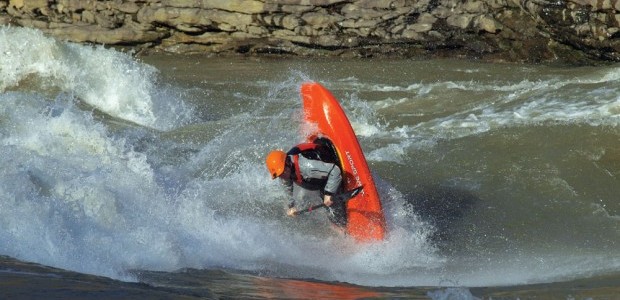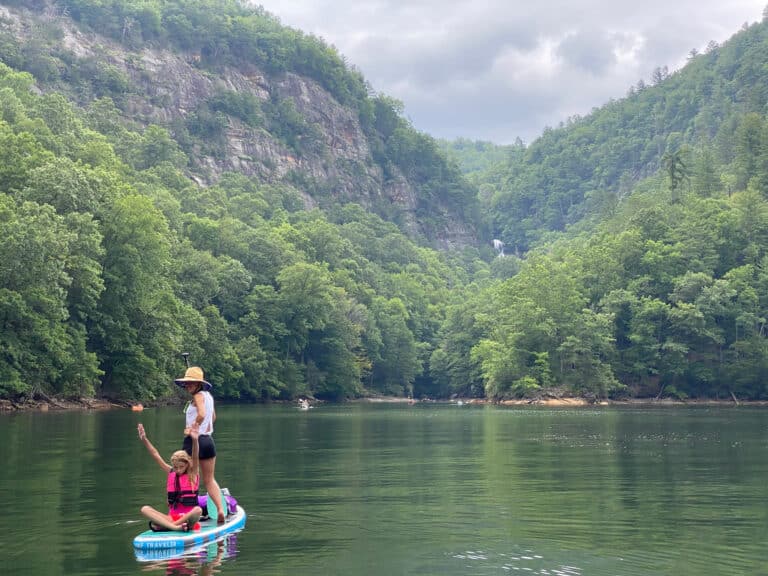Favorite Whitewater Rafting Trip
Gauley River, WV —Brian “Squirrel” Hager, boat guide for 29 years and the most requested guide at Class VI Adventures in West Virginia
You probably know West Virginia’s Gauley River as the wild whitewater ride that comes alive during the annual fall dam releases that make up Gauley Season. During this short window, the Gauley becomes the quintessential “big water” experience in the Southeast. But Gauley season is only one reason why Brian “Squirrel” Hager loves this 25-mile National Scenic River.
“We raft this river all year long, and it’s a completely different animal depending on the amount of water inside the canyon,” Squirrel says. “Every morning, from spring to fall, we wake up, check the gauge, and decide where we’re going to take clients.”
The Gauley has three discernable stretches, Upper, Middle, and Lower. If the water is low, the Middle offers fun class III duckie opportunities and the Upper becomes a more technical creeking run with stellar trout fishing opportunities. If it’s high water, the Upper and Lower offer continuous massive whitewater with some of the best-known rapids in the country.
Whitewater Rafting Cred: “Rivers all over the country dry up during the fall once the snowmelt and spring rain is gone, but because of the dam releases, the Gauley has this great, late season,” Squirrel says. “It’s totally unique.”
You can run the Upper or Lower, or combine them into a 25-mile
rafting extravaganza called the Marathon. Or try the “Double Upper,” which Squirrel says is the most whitewater any human can handle. Run the 10 miles of class V whitewater, get out, and then run it again.
Rapids: Upper Gauley is packed with class V big water. The most memorable rapid? Pillow Rock, where the river constricts while dropping three stories, pushing boats into a massive boulder. And Sweets Falls, a 12-foot vertical drop, will probably stick in your mind long after you’ve said goodbye to your big rubber boat.
Logistics: For six weekends in September and October, the Gauley becomes the center of the whitewater rafting universe on the East Coast. The Upper and Lower sections come alive with more than 2,500 cubic feet per second of water released from the Summersville Dam. Commercial rafting companies will handle all the nitty gritty logistics for you. Act early if you want to book Squirrel.
Chattooga Wild and Scenic River, GA/SC –Jody Tinsley, veteran raft guide with 25 years on the Chattooga and other Southern rivers with Wildwater Rafting
Surrounded by the Sumter and Chattahoochee National Forests, the free-flowing Chattooga river was the first in the South to be designated Wild and Scenic by Congress in 1974. Thanks to that designation and the surrounding public land, it’s just as wild today as when it was used to film scenes for the movie Deliverance. But the scenery is only half the reason why veteran raft guide Jody Tinsley picked the Chattooga as his favorite whitewater rafting river.
“It’s true that you’re not going to find a more beautiful and remote river trip in the East than the Chattooga, but don’t forget that this river is also packed with really technical, really challenging whitewater,” Tinsley says. “It’s a combination that you just can’t find anywhere else around here.”
Rafting Cred: The most popular section of the river is the full-day paddle through section IV, the steepest piece of the Chattooga choked with boulders, big drops, remote cliffs, and class III-IV+ rapids. What makes the Chattooga truly unique, though, is the fact that you won’t see another rafting group during your trip. Only a few guide services are permitted to run trips on the Chattooga, and those trips are spaced out so you never see another boat. Creeks also fall off the steep gorge walls throughout this section, giving you the opportunity to take quick side hikes to lush waterfalls.
Rapids: Section IV is packed with whitewater goodies, the most famous of which is Five Falls–a series of class IV drops separated only by small eddies where the river drops at a drastic 200 feet per mile. Given the fact that the Chattooga is a free-flowing river, the nature of these drops depends largely on recent rainfall. “In low water, it’s like technical creek boating. The drops are bigger, but the pools slow you down,” Tinsley says. “In high water, you move so fast from one drop to the next, you have to be on the ball with every move.” Also, consider tacking on Section III to your trip, which has the Rock Garden, a series of big fin-like rocks sticking out of the water at 50-degree angles. You paddle your way though this section, working your way around these giant fins while navigating class III whitewater.
Logistics: Wildwater runs a number of trips on the Chattooga. Section IV is a must, but you could also sign up for the Chattooga Overnighter, which combines sections III and IV for two days of wilderness whitewater rafting. wildwaterrafting.com








